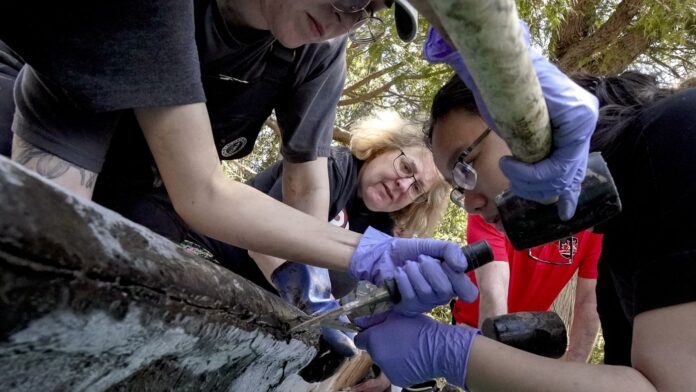The evidence of human activity is evident everywhere, from the top of Mount Everest to the Mariana Trench’s depths — possibly irreversibly. However, a plan to declare the beginning of the Anthropocene, also known as the “Human Epoch,” in geologic time was rejected by a committee made up of eighteen scientists.
What effects would such a vote have, if any? Let me start with some background.
An Earth timeline
Geologists, or scientists who study the Earth, measure the planet’s history using the geologic time scale (GTS). The GTS is separated into aeons, eras, periods, epochs, and ages in descending order of duration (from the formation of Earth, approximately 4.54 billion years ago).
The chronostratigraphic classification is the foundation of the GTS. Geology’s field of stratigraphy is devoted to the study of rock layers, or strata. A branch of stratigraphy called chronostratigraphy (from the Greek “chrono” meaning “relating to time”) examines the relationship between rock strata and the quantification of geological time.
Two aeons, eras, periods, epochs, and ages do not cover the same amount of time (such as days or minutes) in a chronostratigraphic unit. Instead, events that shape the planet and its living conditions—often violent ones like mass extinctions—mark the transition from one to the next. Crucially, there needs to be a distinct, impartial, and globally relevant beginning point for every Earth time interval.
We currently inhabit the Quaternary period, the Holocene epoch, the Meghalayan age, the Phanerozoic aeon, and the Cenozoic era.
The “Human Epoch” as proposed
From the Greek words “holos,” which means “whole,” and “kainos,” which means “new,” the Holocene epoch began approximately 11,700 years ago at the end of the Last Glacial Period (LGP). The average temperature dropped to 8 degrees Celsius, the mean sea level dropped by up to 400 feet, and up to 25% of the Earth’s land surface was covered by glaciers during the LGP.
The Holocene saw an increase in Earth’s temperature, which was directly correlated with the rise and spread of human populations. All of recorded human history occurs during the Holocene, despite the fact that Homo sapiens as a species had evolved well before this period.
Since the year 2000, when American botanist Eugene Stoermer and Dutch meteorologist Paul Crutzen first coined the term Anthropocene, many geoscientists have been intrigued by the notion of a distinct “human” epoch (or “Anthropo”: pertaining to humankind). Anthropocene proponents contend that because of human alteration of the planet, a new geological epoch has begun.
The 37-person Anthropocene Working Group (AWG) started discussing a starting point for the epoch in 2009 and, after years of discussion, settled on the year 1952. The post-World War II era is referred to as the “Great Acceleration” because of the explosive growth in the human population, the increase in fossil fuel consumption, the global spread of radioactive fallout, the widespread use of fertilisers based on nitrogen, and the widespread use of plastics.
Rejecting the suggestion
The International Union of Geological Sciences (IUGS), a representative organisation of over a million geoscientists from over 120 countries and regions committed to global collaboration in the field of geology, received the proposal from the AWG last autumn.
The Subcommission on Quaternary Stratigraphy (SQS), a body that is a part of the International Commission on Stratigraphy (ICS), the largest scientific organisation within the IUGS, began voting on the proposal in February of this year, according to a report from The New York Times.
According to the NYT report, the SQS voted 12 to 4 against the proposal, with 2 abstentions. The IUGS committee concluded that the criteria used to define epochs based on chronostratigraphy did not support the addition of an Anthropocene epoch and the end of the Holocene.
This critique is not brand-new. “Does it really make sense to define the start of a human-dominated era millennia after most forests in arable regions had been cut for agriculture?” was a question posed by geologist Bill Ruddiman and others in Science magazine in 2015.
Erle C. Ellis, an ecologist and environmental scientist who was a member of the AWG, wrote this week for The Conversation: “This proposal risked sowing confusion about the deep history of how humans are transforming the Earth, from climate change and biodiversity losses to pollution by plastics and tropical deforestation.” Ellis linked the beginning of the human age to a recent and devastating event, such as nuclear fallout.
Furthermore, as was already mentioned, epoch boundaries usually denote extremely significant geological change. According to Joseph Desloges, a University of Toronto professor who focuses on the effects of human disturbance and climate change on geomorphic processes, “our last boundary, between the Holocene and the Pleistocene, was almost one-third of this planet being covered by ice” (CBC).
Once more, the GTS is based on records found in solid rocks rather than sediments like those found in Crawford Lake, Ontario, Canada, which were chosen by the AWG’s proposal as the physical location that most clearly demonstrated the end of the Holocene and the beginning of the Anthropocene.
Prof. Desloges stated, “I think people are kind of sceptical about the permanency of it.”
The Anthropocene is living!
It is significant to remember that the SQS voted against the AWG’s narrow definition of the Anthropocene epoch. It was not a vote on whether or not the earth has been permanently altered by humans. There is already overwhelming evidence to support that, and the amount of evidence is growing.
Jan A. Piotrowski, a geoscience professor and one of the committee members who voted against the AWG proposal, told NYT that “there is absolutely no question about this—our impact is here to stay and to be recognisable in the geological record— there is absolutely no question about this.” Prof. Piotrowski stated that “the people that will be coming after us will decide how to rank it.”
For a considerable amount of time, scientists have suggested that the Anthropocene be considered a “event” rather than a brand-new era. Geological terminology refers to events more loosely, which are not listed on the official GTS and therefore do not require committee approval for their start dates.
Even so, a great deal of the planet’s most important events have been classified as events, ranging from the swift growth of biodiversity that filled the sky with oxygen 2.1–2.4 billion years ago to mass extinctions like the one that wiped out the dinosaurs.
The idea that human activity has caused the planet to undergo significant transformation during the Anthropocene is still highly relevant today.



































